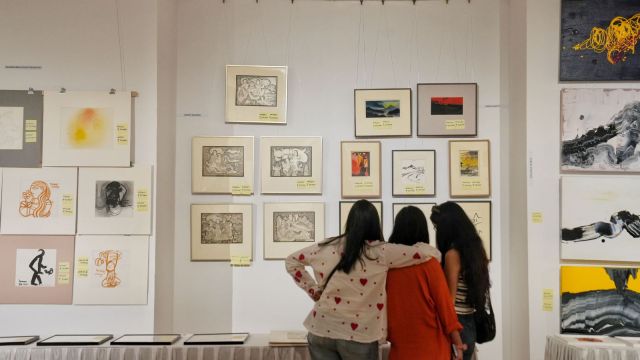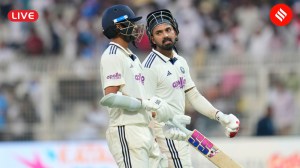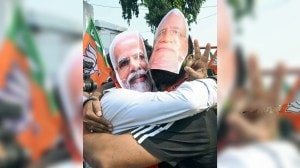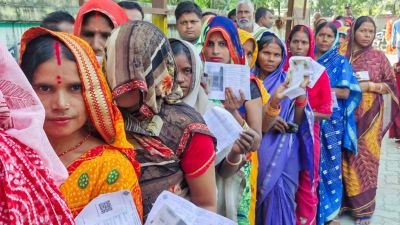‘Art is meant for all’: Seven-day fair in Delhi aims to bridge divide
Organising the mela since 2008 in Kolkata, 2018 in Delhi, and 2020 in Mumbai, Rakhi noted how in each city she has noticed different preferences
 At the CIMA Art Mela on Sunday (Express/Abhinav Saha)
At the CIMA Art Mela on Sunday (Express/Abhinav Saha)It is pure coincidence that in the same week that Indian art set a new record with MF Husain’s 1954 Untitled (Gram Yatra) commanding a remarkable $13.8 million (over Rs 118 crore), Delhi is hosting an art event that underscores the “affordability” of art.
In its fourth edition in the Capital, CIMA Art Mela organised by CIMA art gallery has curated a collection of almost 1,000 artworks by over 65 artists, with prices ranging from Rs 5,000 to Rs 4.95 lakh.
“This is a project that we really believe in. We want people to realise art is meant for all. There is a lot to choose from,” said Rakhi Sarkar, founder-director of CIMA. She added, “Whatever you like, according to your taste, the price is guaranteed, it is authentic and the works are all of good quality.”
So as soon as the doors opened for the seven-day art mela at the Visual Arts Gallery at India Habitat Centre on Sunday, art enthusiasts and connoisseurs began streaming in. “There are seasoned collectors as well those keen to start building a collection or younger collectors acquiring works for their home,” asserted Pratiti Basu Sarkar, Chief Administrator, CIMA.
On the walls is a range, from senior artists such as Arpita and Paramjit Singh to Jogen Chowdhury and Lalu Prasad Shaw to contemporary bigshots such as Paresh Maity and Jayasri Burman, alongside younger artists that include winners of the CIMA Award.
“Some of these young artists could also be future masters,” said Rakhi, adding, “In recent years, we’ve observed that younger artists too are selling extremely well, which is really encouraging for them and it is also good for young collectors who can acquire an original artwork at a lower price… we are bringing the both of them together.”
While traditional art gets its due with the display, including Gond, Pattachitra and Madhubani, so do varied mediums, from watercolours to oil, acrylic, and drawings. “By showcasing traditional folk and tribal art alongside modern and contemporary works, we aim to convey that they belong within the same realm. Our goal is to eliminate the existing divide in perception,” said Pratiti.
If a Paramjit Singh crayon work is priced at Rs 3.50 lakh, a Lalu Prasad Shaw monochrome can cost Rs 1.35 lakh, and Ganesh Pyne limited edition signed prints cost Rs 25,000. Paresh Maity has a suite of watercolours with the price going up to Rs 3.85 lakh for each work, and connoisseurs can own a Jayasri Burman for Rs 1,02,000 to 4.95 lakh.
Ganesh Mohan Shinde’s abstracts are priced under a lakh, Sandip Roy’s watercolours for 28,000 upward, and Anwar Chitrakar’s pattachitras are priced at Rs 34,000.
Organising the mela since 2008 in Kolkata, 2018 in Delhi, and 2020 in Mumbai, Rakhi noted how in each city she has noticed different preferences. “Mumbai typically has a higher demand for abstract works, and it was the same in Delhi last year, where a lot of people were also interested in graphics. Every year, we also change our approach a little and bring in some new names alongside some repetitions. For instance, this year we have a lovely selection of works on paper by masters, well-known artists, and younger names,” she said.
Modelled on Kala Bhavana’s famed Nandan Mela in Santiniketan — which began in 1973 as a fundraiser and then became an annual event to raise funds for students’ welfare at the institute — Rakhi recollected how the first edition of the mela in Kolkata had price points ranging from Rs 500 to Rs 25,000. “We used to have queues that went out on the road… The escalation is in keeping with higher prices that Indian art is fetching now, but the prices we have at the mela are still at least 20 per cent lower than the market price,” she recalled.
Just before the opening, artist-couple Sakti Burman and Maite Delteil paid a visit to the venue to lend their support to the initiative. “It is important to have such initiatives. Art is for all and as artists, we hope that everyone can enjoy it,” stated Sakti.







